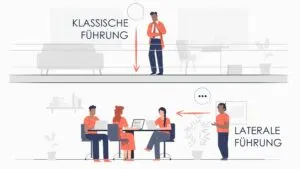Lateral leadership – The most important tips for leading without formal authority
What is lateral leadership?
Das Konzept der lateralen Führung
Where do the differences between lateral and disciplinary leadership lie?
Three important tips that will be decisive for the outcome of your project
Are lateral leaders toothless tigers?
Nine important tips for your self-assessment
Why lateral leadership is becoming more important
Three important examples of application areas
The most important instrument for lateral leadership
Balancing interests
Building motivation
Seven important tools for you as a lateral leader
The most common conflicts in lateral leadership
Critical feedback
Behavioral change
Conflict of interest
Five important tips in conflict management
Lateral leadership – leading effectively without an official supervisor role
The order of the day: Lateral leadership, i.e. leadership without formal
authority. The demands on performance and quality are rising. The time budget is
decreasing. This is how managers face a dilemma: more results despite fewer
resources. They are tempted to exert pressure to ensure that they and their
teams achieve their goals. At the same time, organizational structures are
weakening and hierarchies are being dismantled. In the wake of this process,
supervisors are in fact becoming more and more like project managers. They can
no longer fall back on their superior function. Their position of power is
eroding. This raises the issue of how it is possible to have authority without
being authoritarian. How can employees be induced without pressure?

What is lateral leadership?
Lateral leadership – derived from the Latin word "latus" for
"side" – is not a revolutionary new concept. It has been used for
many years by most organizations. Lateral leadership means "Leading from
the side". This is always the case when people lead the teamwork in teams
without being higher up in the hierarchy or having the authority to give
instructions. In such situations, lateral leadership is usually the instrument
of choice to achieve a common goal.
Lateral leadership is therefore responsible for the outcome of a project
or task without being in charge of the team from a disciplinary point of view.
It is not about "secretly" or informally influencing colleagues.
Lateral leadership is also an "official" form of leadership.
Generally, someone with lateral leadership tasks has a concrete assignment,
which is usually linked to a clear expectation of results.
Das Konzept der lateralen Führung
Increasingly, projects are being implemented outside the traditional
corporate hierarchies – in cross-departmental or even cross-company teams that
are put together on the basis of individual skills. Often, such teams do not
have a disciplinary "leader" as such. In such situations, a lateral
leader is responsible for the project results without being the team's
supervisor.
Employees who are responsible for the outcome of a project or task
without having authority in regards to the discipline of their team should have
the following skills:
be familiar with the concept of lateral leadership, which is becoming
increasingly important todayknow the differences between lateral and disciplinary leadership
understand how leadership works, even without disciplinary power
have tools at their disposal and use them optimally
deal constructively with possible conflicts

Where do the differences between lateral and disciplinary leadership lie?
According to Max Weber, power means:
"the possibility of asserting one's will against that of another"
Applied to the world of work under the guise of disciplinary leadership,
this means:
superiors have the power to issue directives
They control the working time and the agreements of the employment
contract: Does the employee implement the contract as agreed?They check the quality of work of the individual(s) and the team
They take disciplinary action against undesirable or disruptive behavior
of employees, for example by issuing a warning.They deal less with the professional issues of their employees.
The power of the supervisor is rooted in their position. In addition,
they have access to resources and distribute these. Employees who veer from the
expected behavior must expect sanctions.
In contrast, lateral leadership relies on the voluntary commitment of
employees. Leaders try to establish trust, understanding, cooperation and a
common framework of thinking while balancing the different interests.
Three important tips that will be decisive for the outcome of your project
Define your role
Define your tasks
Define your powers
Are lateral leaders toothless tigers?
This question uncovers a certain image of man. Anyone who assumes that
people do not work without pressure may unconsciously hold a pessimistic view
of human nature: people are naturally lazy and selfish. Without pressure, a
person will not perform. Employees must at least be guided and sometimes forced
to work. No employee takes on responsibility voluntarily.
The individual psychologist Alfred Adler made the opposite assumption:
Man is a social animal. He strives for prestige in his group and is therefore
willing to cooperate and take responsibility. According to his observation, man
finds satisfaction in his work. He is by no means averse to work; on the contrary,
work helps him to realize himself. According to this theory, managers are
primarily responsible for creating a performance-enhancing work environment
Their mission is to create a setting in which people want and can work.
Employees, for example, want respect, responsibility and a minimum of
flexibility and self-determination. So they are willing to identify with the
goals of their organization.

If they are unwilling to cooperate, the causes are in the work
environment or they have had bad experiences in the past.
Nine important tips for your self-assessment
Be aware of the differences between disciplinary and lateral leadership.
Use different ways to lead and influence your team – regardless of their
position in the company hierarchy.Develop a clear understanding of your role and responsibilities as a
lateral leader.Officially communicate your role and responsibilities as a lateral
leader to the team.Define clear goals and expectations for your project.
Make it transparent for everyone in the team who is working on which task and
how far he or she has progressed with it.Set clear rules for your teamwork.
Make clear agreements with the disciplinary superiors of your team members on
how much working time they can spend on your project.Deal constructively with conflicts in the team or with disciplinary superiors.
Why lateral leadership is becoming more important
The need for lateral leadership is increasing because the world of work
is changing. In recent years, the way we work together has changed dramatically:
Employees and experts work in increasingly complex project structures.

Companies are dismantling hierarchies, structures are becoming flatter.
Professional and disciplinary management is often separate.
Companies organize themselves in matrix structures.
In general, the project aspect of work is increasing.
In the VUCA world, the boundary conditions change so quickly that solutions
often have to be found in a circle of experts, e.g. agile project management.
This is why employees and external staff, sometimes even employees from
neighboring companies, come together in the work teams.
None of these scenarios speak in favor of the classic disciplinary
approach. Add to this the cultural change – employees have become more
self-confident. The attempt to exert pressure is met with incomprehension,
especially among younger employees. The self-image of employees has changed:
They want to get involved and perform. They know that their skill is needed.
Why should they let themselves be treated like reluctant subordinates?
Three important examples of application areas
Inter-departmental projects to find solutions to complex problems.
Inter-company projects to manage even very large, demanding and
capital-intensive projects.So-called supply-chain-projects, to optimize processes along the value
chain.
Sehen Sie sich einige Beispiele in diesem Auszug aus dem E-Learning "Laterale Führung - wirksam führen ohne Vorgesetztenfunktion" an:
The most important instrument for lateral leadership
Lateral leadership derives its effect from removing obstacles to work
and building motivation. It thrives on commitment, trust, good communication
and knowledge of human nature.
Balancing interests
Lateral leadership focuses on balancing interests as much as possible.
Leaders benefit from knowing their employees, as well as their wishes, motives
and skills. In this way, they can respond to these and use their employees
optimally according to their abilities. Adjusting screws are, for example:
Building positive relationships with staff and within the team.
Recognizing performance
Creating a pleasant working atmosphere.
Equipping the workplaces properly and provide the necessary equipment.
Assigning interesting tasks and responsibilities.
Absorbing external pressures and power.
Building up competence and expertise.
Building motivation
Different people can be motivated in different ways, depending on their
personality structure: some appreciate being on stage. Others get absorbed in
detail work and analysis. Others love teamwork.
Lateral leadership therefore requires a genuine understanding of human
nature in order to make meaningful use of employees according to their personal
inclination and skills. The task is to meet the employees' professional and
personal needs as far as possible so that they voluntarily give their best.

However, conditions are not always suitable. There are always unpopular tasks in a project. Managers should address their staff in this order:
Deal: Rewards if the task is fulfilled as desired.
Support relationship with employees: What are your personal reasons for
engaging the employee in the leadership?Insight and duty: Appeal to the employees' sense of duty.
Control: Involving the next highest superior.
Managers should address their employees in this order. When disruptions
arise, it is important to document the course of the conversation, announce a
possible escalation in good time and, where necessary, consistently take
action.
Seven important tools for you as a lateral leader
Develop a project vision
Agree on goals
Define rules on cooperation
Schedule regular meetings
Design an overview of all tasks
Use virtual platforms
Schedule in presentations for all participants
Wichtige und praktische Führungswerkzeuge stellt Ihnen dieser Auszug aus dem E-Learning "Laterale Führung - wirksam führen ohne Vorgesetztenfunktion" vor:
The most common conflicts in lateral leadership
Critical feedback
Criticism is sometimes necessary. But no employee enjoys being
criticized. Criticism means someone has done something wrong. Those who have to
accept criticism often feel small and humiliated. In lateral leadership,
managers must always bear this in mind. To ensure that criticism leads to the
desired result and causes little damage, leaders should follow these tips:
Make your criticism promptly and discreetly, but never in front of other
colleagues.Weigh the costs and benefits: What can really be gained?
Review your own assessment.
Properly dose the criticism.
Ask for the self-assessment of the person criticized.
Behavioral change
A second source of conflict is desired behavioral change. Disciplinary
senior staff have the necessary means to do this: the performance review, the
agreement on objectives or the ongoing monitoring of results.
Lateral leadership does not have these instruments. Moreover, managers and
employees often only work together on specific projects. The continuity of
cooperation is correspondingly low.
What is the reason for the undesirable behavior? Is the employee unaware? Can't
they, or do they not want to, do the task? Finding this out is the first step.
Then the manager can intervene in a targeted manner – they can lead their
employee according to their level of maturity or try to motivate them.
Conflict of interest
There is a long list of possible types of conflict: conflicts over
goals, conflicts over evaluation, conflicts over distribution, personal
conflicts, conflicts over relationships and roles. In lateral leadership, the
risk of the manager getting caught in the middle is high.
In lateral leadership, the key to success lies in engaging with
employees, negotiating skills, and conflict resolution skills. Good leaders
succeed in getting employees to pull together voluntarily.
Consequently, leaders should be well trained in conflict resolution strategies.
Five important tips in conflict management
Identify the causes
Make your own experience clear
Make clear agreements
Conduct individual discussions
Agree on joint appointments
Lateral leadership – leading effectively without an official supervisor
role
Do you want to prepare yourself and your employees for your role as a
lateral leader?
Take a look at the "Lateral Leadership – Effective leadership without an
official supervisor role" e-learning course. The multimedia and
video-based e-training course contains a professional learning moderator,
explanatory videos, realistic drama scenes, learning questions and transfer
tasks, as well as a summary of the key messages and a final test. Do you want
to see it for yourself? We will give you free trial access to our to
our e-learning library as a human resources manager.
